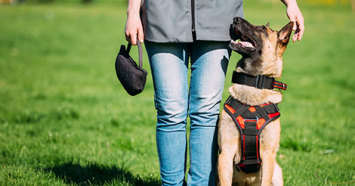
Many of the problems that occur between dogs and owners are the result of a communication gap. Dogs may be a part of our family but they are of a different species and sometimes communication breaks down. Teaching your dog to understand a vocabulary of basic commands will go a long way towards alleviating misunderstandings.
Teaching your dog what a particular command means requires you to help the dog do what you want him to do, use the command to identify that action, and reward him for doing it. In other words, when your dog’s hips touch the floor, say “Sweetie, sit,” and praise and reward him for sitting. Later, when he understands the word for sitting, and cooperating with you, then you can ask him to sit and expect him to do it. In the beginning, however, help him do it.
The sit command is an easy example, of course, and not all verbal communication will be as easy to teach. The process is basically the same though.
A Basic Vocabulary of Dog Commands
Every dog owner should establish a list of basic commands to train with. These commands can create a foundation of communication and later, when these are understood, then you can add additional commands.
Your vocabulary can vary, obviously, as the relationship between you and your dog is unique. Plus your daily routine will be different. If you participate in any dog sports or activities, you’ll need to teach additional words. However, here are some suggestions:
Sit. The sit command means the dog’s hips are on the ground while the shoulders are upright. The dog should remain in position until released.
Come. The come command in dog training means stop what you’re doing, ignore distractions, and go directly to the owner.
Down. In dog training, the down command means lie down on the floor (or ground) and hold that position until released.
Stay. Remain in position while the owner walks away from the dog and the dog holds still until he’s released.
Release. This is the word that tells the dog he can move from the position he’s been in.
Yes. A verbal marker to let the dog know his actions are correct.
Good dog/good boy/good girl. Verbal praise that can be used after the ‘yes’ marker or after the dog is released.
Leave it. Telling your dog to "leave it" means to ignore what you’re paying attention to; whether it’s food on the floor or the dogs barking next door.
Outside. What is your word or phrase for the dog to go outside to relieve himself?
Go to bed. This sends the dog to his bed or crate.
Dinner. This word, or the phrase, “Are you hungry?”, signals that it’s time to eat.
Go for a walk. It’s time to go for a walk.
Get it. Please get your ball, toy, or the newspaper.
Bring it here. Bring me your ball, toy, or newspaper.
Drop it. Spit out what’s in your mouth.
Keep Commands Consistent
What else is important to you? You might want to tell your dog to get off the furniture and ‘off’ could work. Don’t use ‘down’ as that already has a meaning (lie down) and each word should only have one meaning for your dog. ‘Wait’ can mean don’t dash out open doors or gates.
Think about your daily routine, the games you play, and the work you ask your dog to do. Each of these can increase your dog’s vocabulary.
Tone of Voice
When teaching your dog this vocabulary – or a new command – pay attention to your tone of voice. Don’t yell at your dog; he can hear very well. Plus, a loud unhappy tone of voice isn’t going to teach him anything other than the fact that you are unhappy.
Instead, show him what you want him to do, praise and reward him for cooperation, and then teach him the word. Repeat a few times and then come back later and repeat the exercise. Three to five repetitions are more than enough at one time. Too many repetitions and your dog will get frustrated, bored, or distracted.
A happy tone of voice, a smile, a good treat, patience, and a willingness to teach your dog will go a long way to increase communication.
